Measurement and Analysis of Vibration Levels in Stacked Small Package Shipments in Delivery Vans as a Function of Free Movement Space
Abstract
1. Introduction
2. Materials and Methods
2.1. Testing Sample and Data Recorder Settings
2.2. Stacked Unit and Free Movement Space (FM)
- No FM (0% free movement space);
- FM of ±5% in the width/length of the box (total of 10% FM);
- FM of ±10% in the width/length of the box (total of 20% FM).
2.3. Vehicle and Delivery Routes
2.4. Statistical Methods for Acceleration Peaks
2.5. Data Analysis for Power Spectral Density (PSD) and Transmissibility
3. Results and Discussion
3.1. Acceleration Levels
3.2. Vibration Levels in Stacked Units and the Effect of FM, and Transmissibility
3.3. Statistical Characteristics of Acceleration Peaks
3.4. Limitations
4. Conclusions
Author Contributions
Funding
Conflicts of Interest
Appendix A
| Acceleration Data (g, Peak) | FM | Location | Kurtosis | Skewness |
|---|---|---|---|---|
| Lateral | 0% | Floor | 8.08 | 2.54 |
| 1st | 17.23 | 2.27 | ||
| 2nd | 8.77 | 2.54 | ||
| 3nd | 19.83 | 3.29 | ||
| 10% | Floor | 9.19 | 2.89 | |
| 1st | 9.28 | 2.15 | ||
| 2nd | 12.40 | 2.73 | ||
| 3nd | 16.86 | 3.16 | ||
| 20% | Floor | 12.12 | 3.57 | |
| 1st | 12.43 | 2.65 | ||
| 2nd | 19.71 | 3.87 | ||
| 3nd | 14.85 | 3.04 | ||
| Longitudinal | 0% | Floor | 8.51 | 2.46 |
| 1st | 5.97 | 1.99 | ||
| 2nd | 9.64 | 2.26 | ||
| 3nd | 14.48 | 3.35 | ||
| 10% | Floor | 8.22 | 2.71 | |
| 1st | 9.41 | 2.47 | ||
| 2nd | 11.7 | 3.17 | ||
| 3nd | 9.28 | 2.87 | ||
| 20% | Floor | 8.23 | 2.75 | |
| 1st | 12.41 | 3.01 | ||
| 2nd | 15.86 | 3.43 | ||
| 3nd | 11.73 | 2.72 | ||
| Vertical | 0% | Floor | 5.06 | −0.74 |
| 1st | 2.36 | 0.38 | ||
| 2nd | 1.98 | 0.83 | ||
| 3nd | 1.18 | 0.50 | ||
| 10% | Floor | 6.76 | −0.67 | |
| 1st | 3.34 | 0.59 | ||
| 2nd | 2.62 | 1.10 | ||
| 3nd | 1.80 | 0.91 | ||
| 20% | Floor | 5.12 | −0.37 | |
| 1st | 3.49 | 0.36 | ||
| 2nd | 3.04 | 0.66 | ||
| 3nd | 1.56 | 0.67 |
References
- Mazarenau, E. Global Size of the Courier, Express and Parcel (CEP) Market 2009–2019. Statista.com. Available online: https://www.statista.com/statistics/723986/cep-market-total-revenue-worldwide/ (accessed on 14 September 2020).
- Lin, C.C.; Sheu-Hua, C. The hierarchical network design problem for time-definite express common carriers. Transp. Res. B Methodol. 2004, 38, 271–283. [Google Scholar] [CrossRef]
- Böröcz, P.; Singh, S.P. Measurement and analysis of delivery van vibration levels to simulate package testing for parcel delivery in Hungary. Packag. Technol. Sci. 2018, 31, 342–352. [Google Scholar] [CrossRef]
- Brandenburg, R.K.; Lee, J.J. Fundamentals of Packaging Dynamics; L.A.B. Equipment, Inc.: Itasca, IL, USA, 2001. [Google Scholar]
- Zhou, H.; Wang, Z.W. Measurement and analysis of vibration levels for express logistics transportation in South China. Packag. Technol. Sci. 2018, 31, 665–678. [Google Scholar] [CrossRef]
- Chonhenchob, V.; Singh, S.P.; Singh, J.; Stallings, J.; Grewal, G. Measurement and analysis of vehicle vibration for delivering packages in small-sized and medium-sized trucks and automobiles. Packa. Technol. Sci. 2012, 25, 31–38. [Google Scholar] [CrossRef]
- Stallings, J.; Singh, J.; Singh, S.P. Measurement and Analysis of Vehicle Vibration for Parcel Delivery Vehicles in Single Parcel Shipments. J. Appl. Packag. Res. 2010, 4, 75–82. [Google Scholar]
- Park, J.; Choi, S.; Jung, H.M. Measurement and Analysis of Vibration Levels for Truck Transport Environment in Korea. Appl. Sci. 2020, 10, 6754. [Google Scholar] [CrossRef]
- Singh, S.P.; Marcondes, J.A. Vibration levels in commercial truck shipments as a function of suspension and payload. J. Test. Eval. 1992, 20, 466–469. [Google Scholar] [CrossRef]
- Böröcz, P. Vibration levels in vans as a function of payload and leaf spring sheet number. J. Test. Eval. 2017, 46, 236–243. [Google Scholar] [CrossRef]
- ASTM D7386‐12. Standard Practice for Performance Testing of Packages for Single Parcel Delivery Systems; ASTM International: West Conshohocken, PA, USA, 2012. [Google Scholar] [CrossRef]
- ISTA Procedure 3A. Packaged‐Products for Parcel Delivery System Shipments 70 kg (150 lb) or Less (Standard, Small, Flat or Elongated); International Safe Transit Association: East Lansing, MI, USA, 2006. [Google Scholar]
- Rouillard, V.; Sek, M.A. Synthesizing nonstationary, non-Gaussian random vibrations. Packag. Technol. Sci. 2010, 23, 423–439. [Google Scholar] [CrossRef]
- Rouillard, V. On the Synthesis of Non-Gaussian Road Vehicle Vibrations. Ph.D. Thesis, Dept. of Mechanical Engineering, Monash University, Melbourne, Australia, 2006. [Google Scholar]
- Böröcz, P. Averaged vibration levels during courier parcel delivery service in small truck in Hungary. FME Trans. 2018, 46, 211–217. [Google Scholar] [CrossRef]
- Molnár, B.; Böröcz, P. Performance and analysis of unitized stacked load units under vibration simulation. FME Trans. 2020, 48, 96–101. [Google Scholar] [CrossRef]
- Rouillard, V. On the Non-Gaussian Nature of Random Vehicle Vibrations. In Proceedings of the World Congress on Engineering Vol II, London, UK, 2–4 July 2007. [Google Scholar]
- Otari, S.; Odof, S.; Nolot, J.B.; Vasseur, P.; Pellot, J.; Krajka, N.; Erre, D. Statistical characterization of acceleration levels of random vibrations during transport. Packag. Technol. Sci. 2011, 24, 177–188. [Google Scholar] [CrossRef]
- Garcia-Romeu-Martinez, M.A.; Rouillard, V.; Cloquell-Ballester, V.A. A Model for the Statistical Distribution of Road Vehicle Vibrations. In Proceedings of the World Congress on Engineering, Vol II, London, UK, 2–4 July 2007. [Google Scholar]
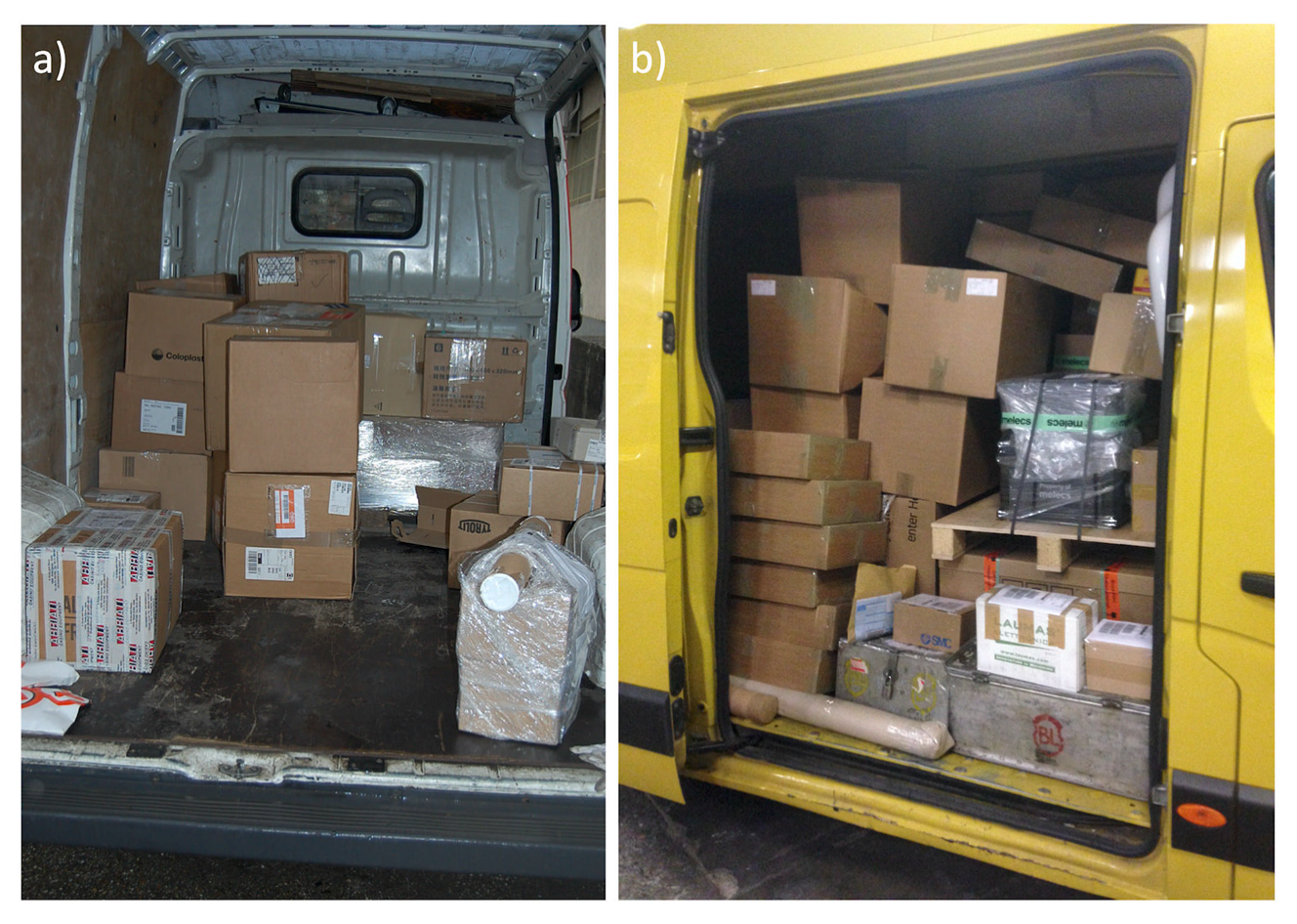

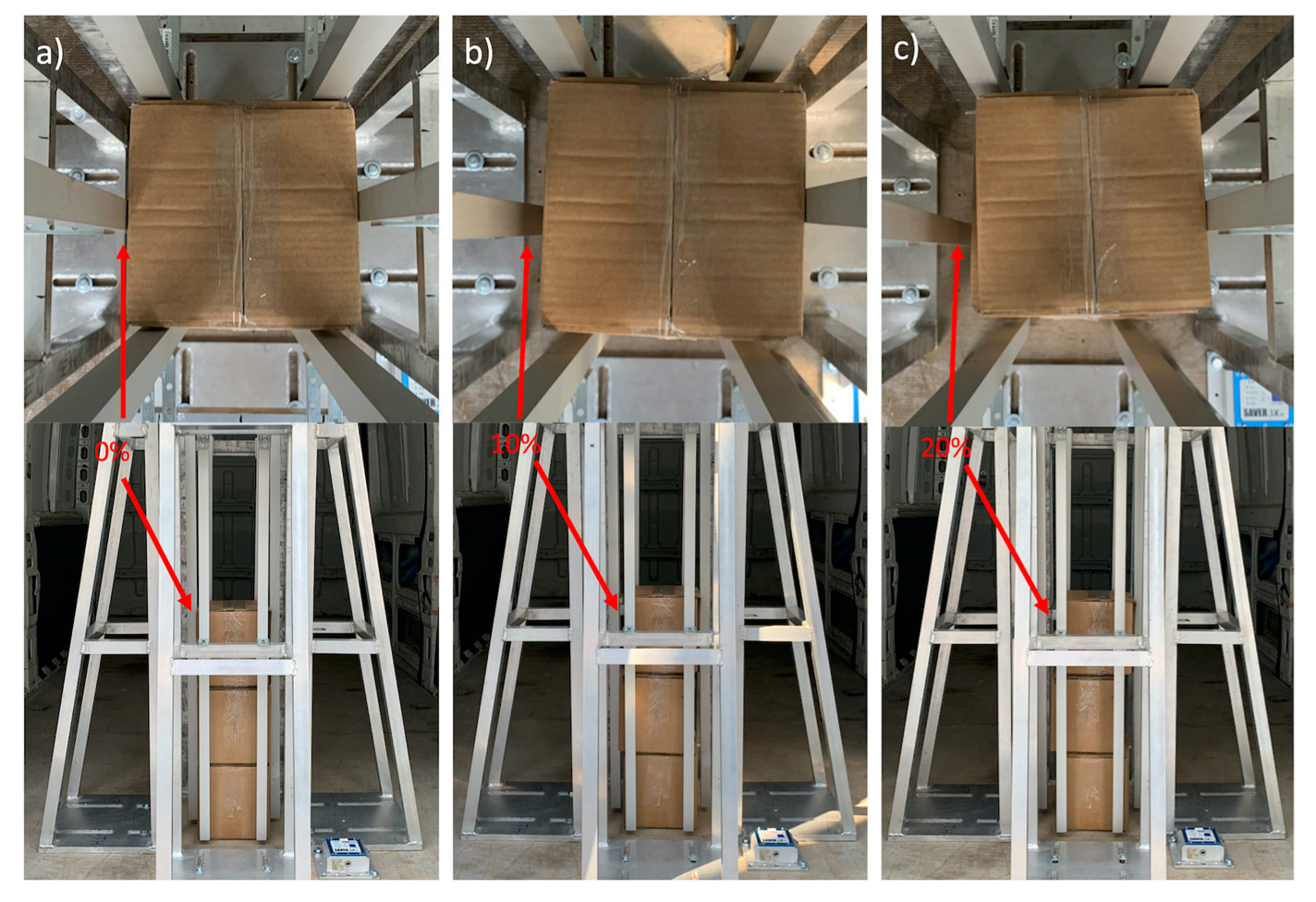
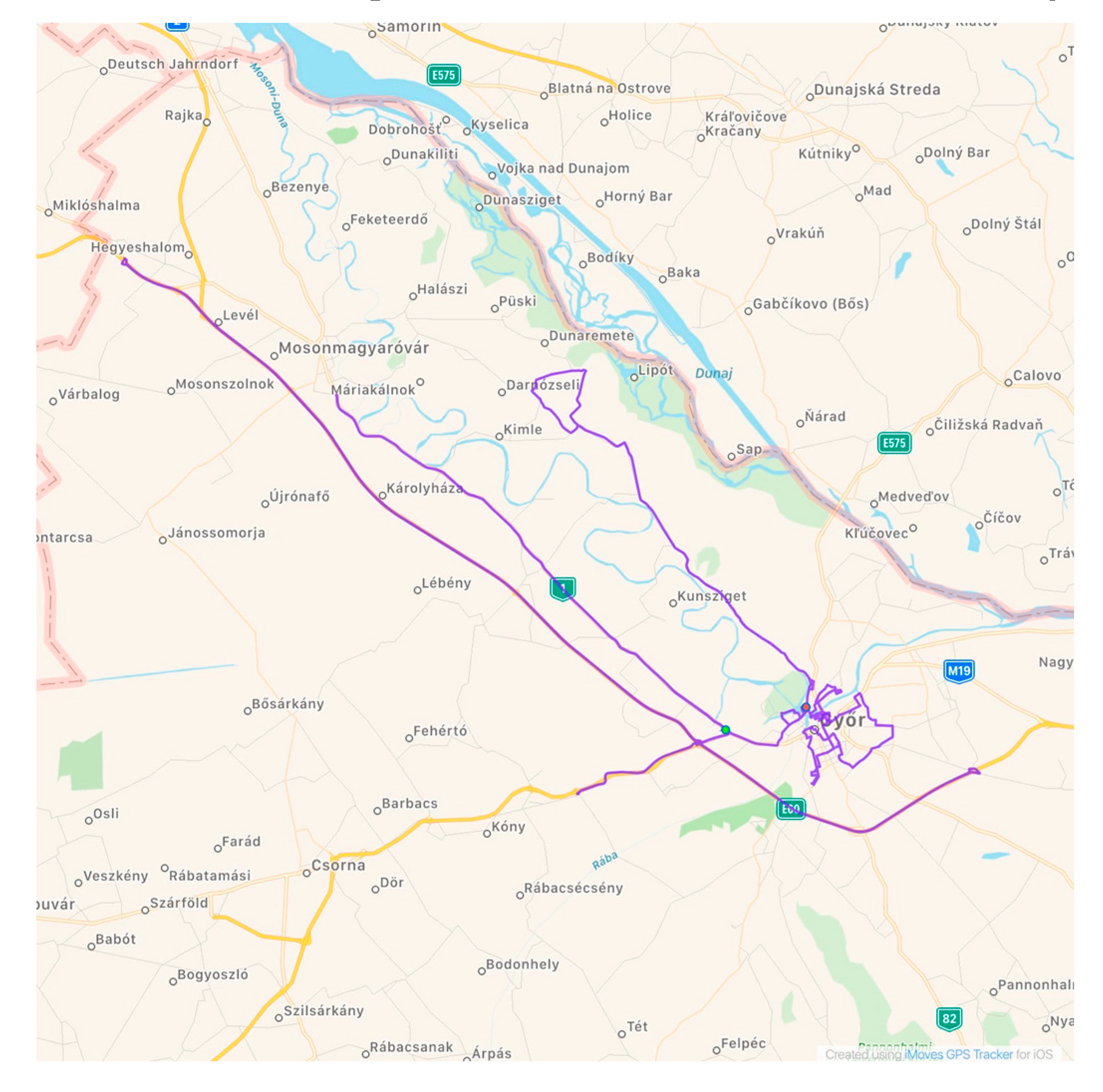
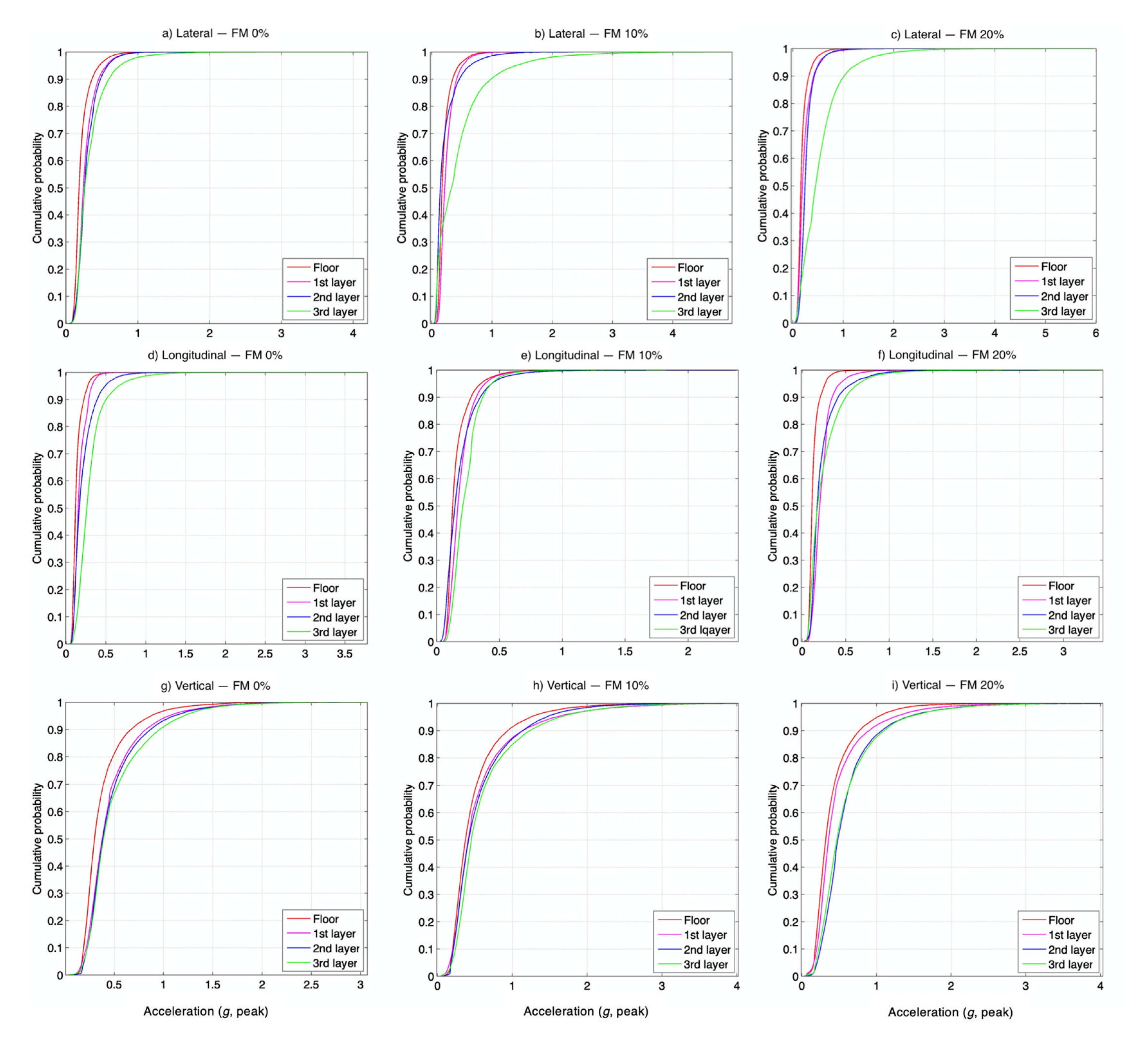
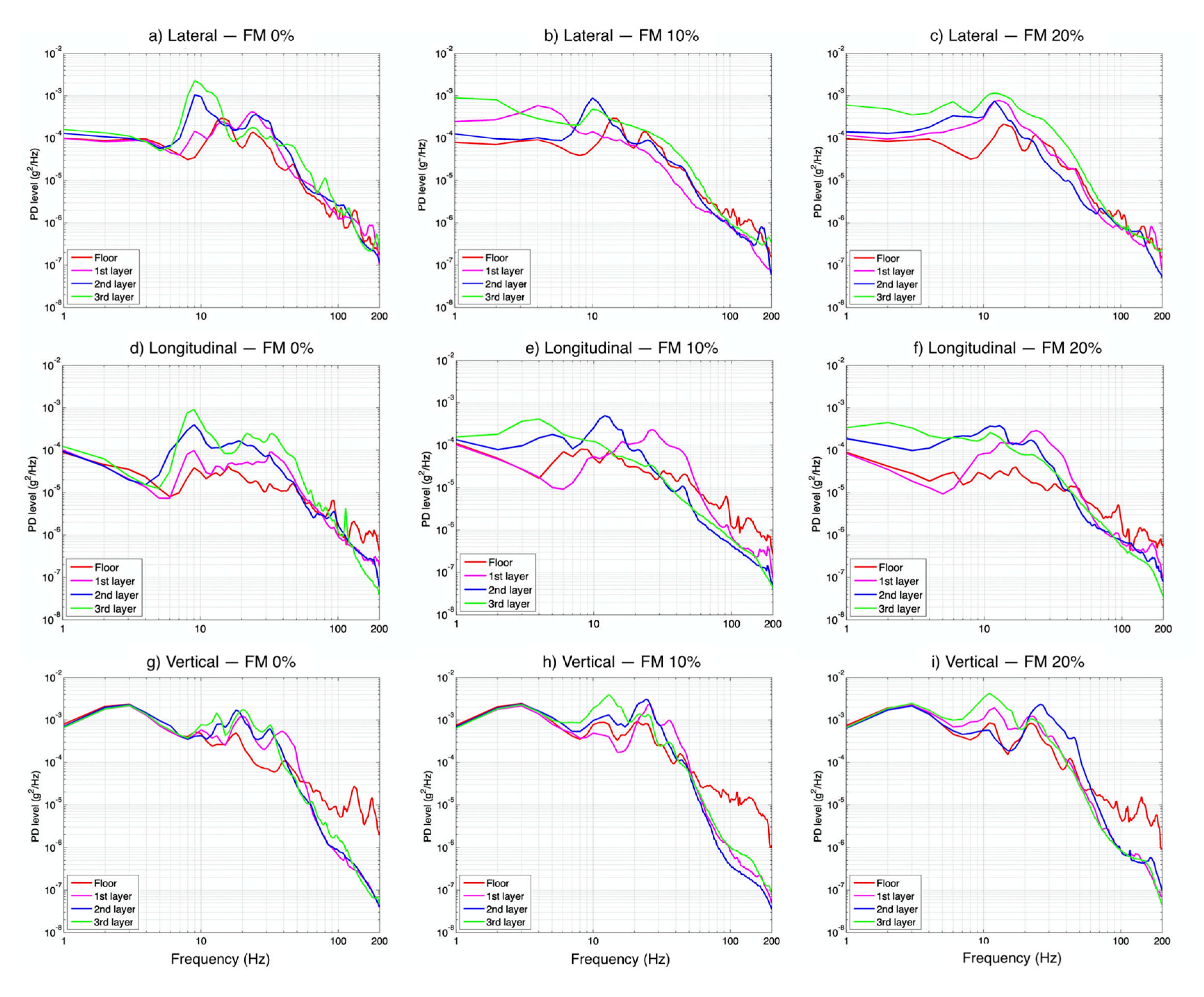

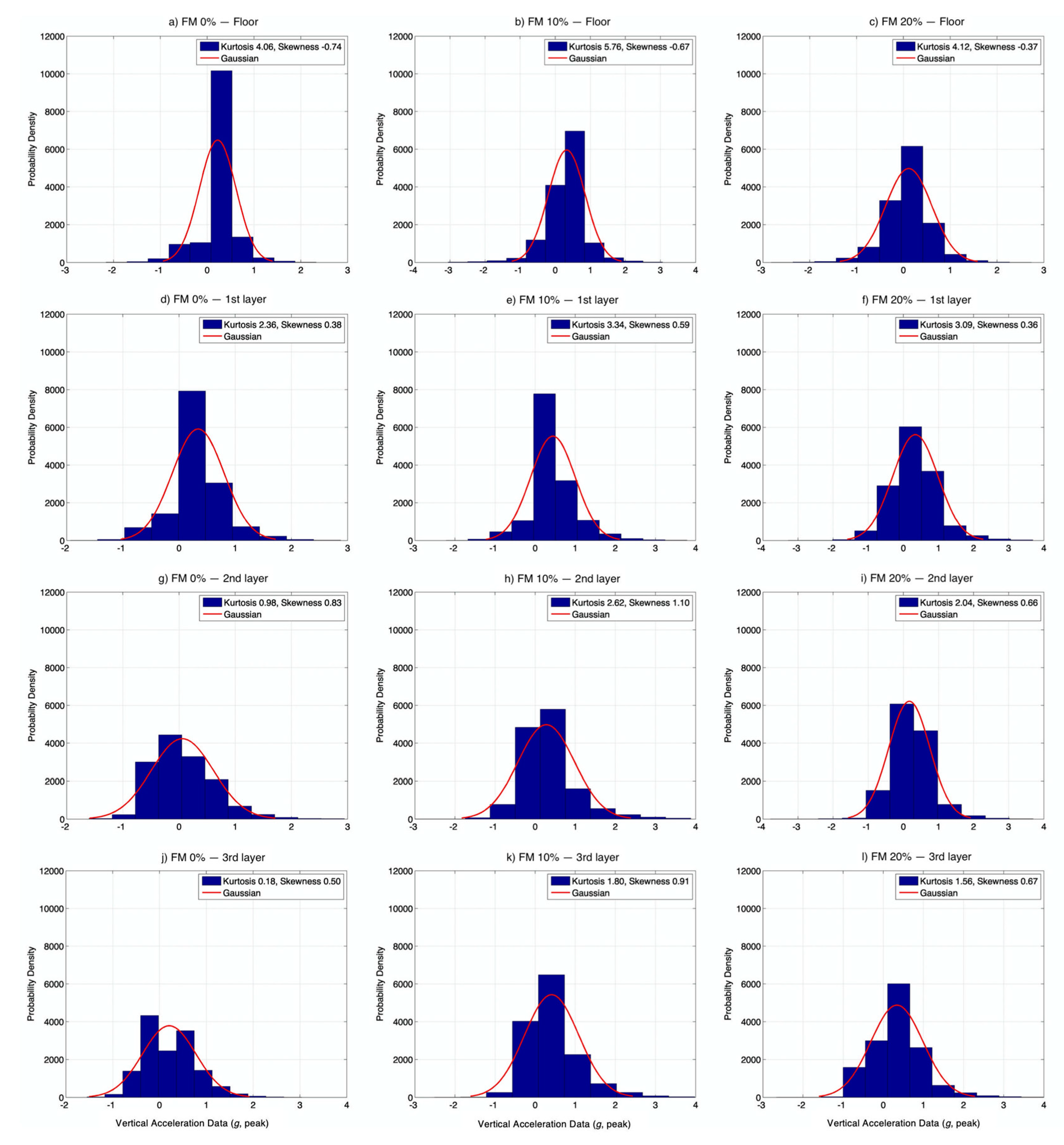
| Samples Used | SAVERs | ||
|---|---|---|---|
| Corrugated board | 35BC | Timer triggered data | 1 s |
| Weight of board | 742 g/m2 | Wake-up interval | 1 s |
| ECT (Edge Crush Test) | 9.0 kN/m | Recording time | 1.000 s |
| BST (Bursting Strength Test) | 1685 kPa | Samples/sec | 500 Hz |
| Weight of box | 190 g | Sample size | 500 |
| Size of box (w × d × h) | 180 × 180 × 195 mm | Frequency resolution (PSD) | 0.50 Hz |
| Weight of ALU frame | 1440 g | Anti-aliasing frequency | 200 Hz |
| Entire weight | 2630 g | ||
| FM 0% | FM 10% | FM 20% | ||||
|---|---|---|---|---|---|---|
| Distance (km) | Average Speed (km/h) | Distance (km) | Average Speed (km/h) | Distance (km) | Average Speed (km/h) | |
| Motorway | 120.9 | 114 | 120.7 | 115 | 121.4 | 117 |
| Arterial | 80.2 | 73 | 79.8 | 68 | 80.1 | 71 |
| Country | 51.5 | 54 | 51.4 | 57 | 51.2 | 53 |
| Urban | 38.4 | 35 | 38.7 | 34 | 39.0 | 37 |
| Summary | 291.0 | 69.1 | 290.6 | 68.1 | 291.7 | 69.7 |
| Acc. Data (g, Peak) | FM | Location | Max. Acc. | Acc. at 99% Occurrence | Acc. at 95% occ. | Acc. at 90% occ. | Acc. at 50% occ. |
|---|---|---|---|---|---|---|---|
| Lateral | 0% | Floor | 1.24 | 0.68 | 0.46 | 0.36 | 0.18 |
| 1st | 1.41 | 0.79 | 0.56 | 0.45 | 0.24 | ||
| 2nd | 2.40 | 0.80 | 0.58 | 0.48 | 0.26 | ||
| 3nd | 4.16 | 1.24 | 0.75 | 0.59 | 0.26 | ||
| 10% | Floor | 1.58 | 0.68 | 0.45 | 0.38 | 0.17 | |
| 1st | 2.15 | 0.74 | 0.51 | 0.41 | 0.22 | ||
| 2nd | 2.35 | 1.09 | 0.63 | 0.46 | 0.15 | ||
| 3nd | 4.93 | 2.50 | 1.39 | 0.98 | 0.33 | ||
| 20% | Floor | 1.33 | 0.65 | 0.41 | 0.32 | 0.16 | |
| 1st | 1.91 | 0.86 | 0.54 | 0.41 | 0.19 | ||
| 2nd | 2.81 | 0.84 | 0.55 | 0.43 | 0.24 | ||
| 3nd | 5.94 | 2.19 | 1.34 | 1.02 | 0.45 | ||
| Longitudinal | 0% | Floor | 0.96 | 0.38 | 0.27 | 0.22 | 0.11 |
| 1st | 1.81 | 0.41 | 0.32 | 0.28 | 0.15 | ||
| 2nd | 1.94 | 0.72 | 0.49 | 0.39 | 0.16 | ||
| 3nd | 3.74 | 1.07 | 0.66 | 0.50 | 0.26 | ||
| 10% | Floor | 1.11 | 0.55 | 0.35 | 0.27 | 0.13 | |
| 1st | 1.72 | 0.59 | 0.38 | 0.31 | 0.19 | ||
| 2nd | 1.82 | 0.61 | 0.43 | 0.35 | 0.16 | ||
| 3nd | 2.38 | 0.71 | 0.43 | 0.36 | 0.20 | ||
| 20% | Floor | 1.56 | 0.37 | 0.26 | 0.21 | 0.11 | |
| 1st | 2.08 | 0.67 | 0.43 | 0.34 | 0.17 | ||
| 2nd | 3.02 | 0.94 | 0.57 | 0.41 | 0.18 | ||
| 3nd | 3.42 | 1.05 | 0.65 | 0.49 | 0.20 | ||
| Vertical | 0% | Floor | 2.33 | 1.40 | 0.87 | 0.67 | 0.31 |
| 1st | 2.88 | 1.67 | 1.26 | 0.82 | 0.38 | ||
| 2nd | 2.94 | 1.69 | 1.29 | 0.87 | 0.39 | ||
| 3nd | 3.04 | 1.72 | 1.41 | 0.96 | 0.39 | ||
| 10% | Floor | 3.06 | 2.05 | 1.26 | 0.94 | 0.37 | |
| 1st | 3.79 | 2.18 | 1.46 | 1.14 | 0.41 | ||
| 2nd | 3.88 | 2.62 | 1.64 | 1.14 | 0.42 | ||
| 3nd | 3.98 | 2.82 | 1.66 | 1.24 | 0.45 | ||
| 20% | Floor | 2.82 | 1.52 | 1.01 | 0.77 | 0.32 | |
| 1st | 3.69 | 2.06 | 1.24 | 0.91 | 0.36 | ||
| 2nd | 3.78 | 2.30 | 1.42 | 1.09 | 0.47 | ||
| 3nd | 3.99 | 2.36 | 1.43 | 1.10 | 0.48 |
| FM | Location | Lateral | Longitudinal | Vertical |
|---|---|---|---|---|
| 0% | Floor | 0.064 | 0.037 | 0.136 |
| 1st | 0.085 | 0.051 | 0.166 | |
| 2nd | 0.101 | 0.069 | 0.170 | |
| 3rd | 0.118 | 0.095 | 0.181 | |
| 10% | Floor | 0.063 | 0.044 | 0.146 |
| 1st | 0.068 | 0.057 | 0.193 | |
| 2nd | 0.079 | 0.067 | 0.216 | |
| 3rd | 0.098 | 0.070 | 0.217 | |
| 20% | Floor | 0.059 | 0.036 | 0.149 |
| 1st | 0.081 | 0.070 | 0.182 | |
| 2nd | 0.090 | 0.073 | 0.204 | |
| 3rd | 0.135 | 0.075 | 0.216 |
Publisher’s Note: MDPI stays neutral with regard to jurisdictional claims in published maps and institutional affiliations. |
© 2020 by the authors. Licensee MDPI, Basel, Switzerland. This article is an open access article distributed under the terms and conditions of the Creative Commons Attribution (CC BY) license (http://creativecommons.org/licenses/by/4.0/).
Share and Cite
Böröcz, P.; Molnár, B. Measurement and Analysis of Vibration Levels in Stacked Small Package Shipments in Delivery Vans as a Function of Free Movement Space. Appl. Sci. 2020, 10, 7821. https://doi.org/10.3390/app10217821
Böröcz P, Molnár B. Measurement and Analysis of Vibration Levels in Stacked Small Package Shipments in Delivery Vans as a Function of Free Movement Space. Applied Sciences. 2020; 10(21):7821. https://doi.org/10.3390/app10217821
Chicago/Turabian StyleBöröcz, Péter, and Bence Molnár. 2020. "Measurement and Analysis of Vibration Levels in Stacked Small Package Shipments in Delivery Vans as a Function of Free Movement Space" Applied Sciences 10, no. 21: 7821. https://doi.org/10.3390/app10217821
APA StyleBöröcz, P., & Molnár, B. (2020). Measurement and Analysis of Vibration Levels in Stacked Small Package Shipments in Delivery Vans as a Function of Free Movement Space. Applied Sciences, 10(21), 7821. https://doi.org/10.3390/app10217821






